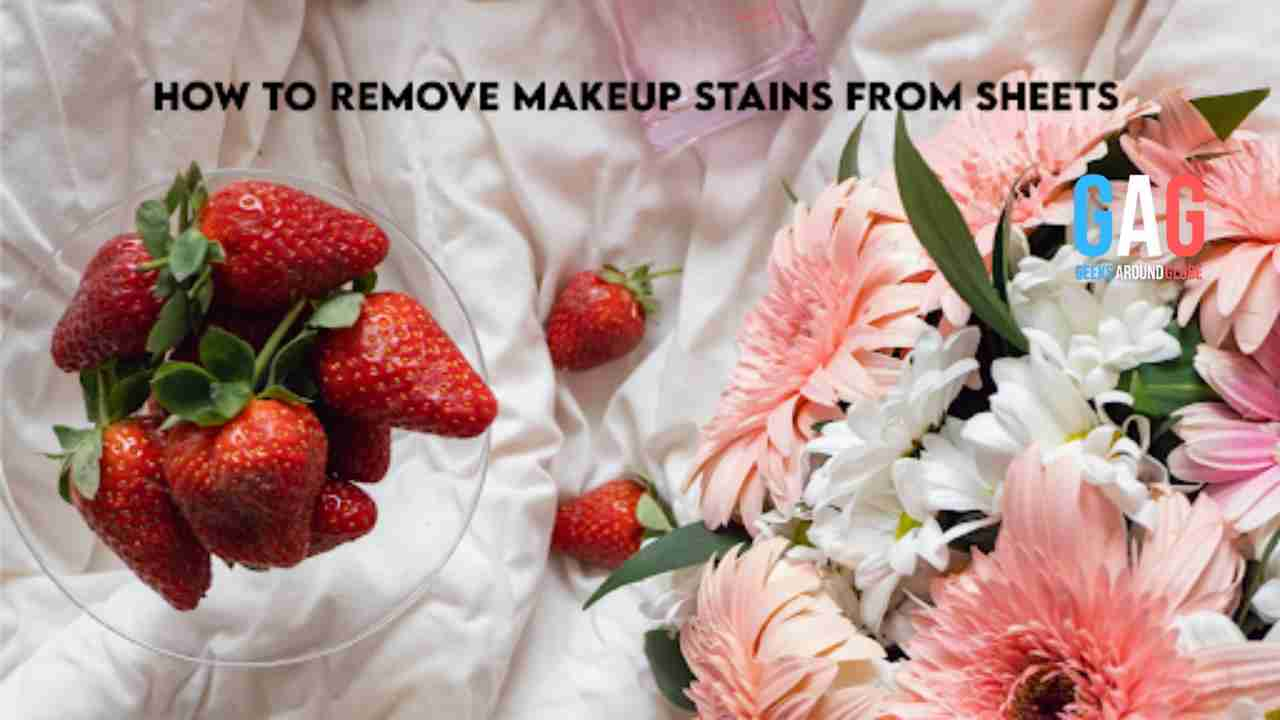Makeup stains on sheets are a common problem we all experience, especially if you enjoy wearing makeup to bed and this is all about ladies’ behavior. Removing makeup stains from sheets can be a challenging task, but it’s not impossible. We understand the struggle if you have ever gone to sleep without removing your makeup. It’s a common mistake, and fortunately, it usually doesn’t cause any harm. However, sometimes, we wake up to find our pillows and sheets stained with makeup, which can be frustrating, especially when dealing with white bedding. It may seem difficult to remove dark red lipstick or black mascara streaks, but with the right approach, you can learn how to remove makeup from sheets like a professional.
Due to the variety of cosmetic formulas, such as liquid, powder, and cream, there is no general solution for removing cosmetic stains. Compounding the issue is the presence of various ingredients in cosmetics, making stain removal even more difficult. Makeup stains are typically caused by water-based or oil-based cosmetics, which cannot be easily removed by machine-washing alone. In this article, we will discuss some effective ways to remove makeup stains from sheets.

Remove Stubborn Makeup Stains From Your Bedding With These Easy Steps
Figure out what stain and material you’re dealing with
Identifying the type of stain is crucial for efficient removal. It may seem like an obvious first step, but it can significantly impact the cleaning process and make you get the exact solution to your problem without wasting much time on the washing process. Is the stain caused by oil-based lipstick or powder eyeshadow? Are your sheets made of a cotton blend or a delicate fabric like silk? Before you begin applying a mixture of cleaning solutions to your bedding, it’s important to address these questions as various cleaning solvents perform better on specific stains and fabrics. (I will discuss the ideal solutions for each stain later.) After answering these questions, you can begin the cleaning process immediately. The longer the stain remains, the deeper it penetrates the fabric, making it increasingly challenging to remove.
As mentioned earlier, acting quickly is essential when trying to remove makeup stains from sheets. The longer the stain remains on the fabric, the harder it will be to remove. If you can’t wash the sheet immediately, try to blot the stain with a clean cloth or paper towel to absorb as much makeup as possible. This will prevent the stain from setting into the fabric and make it easier to remove later. Cold water is the best option for rinsing out makeup stains. Hot water can set the stain into the fabric, making it harder to remove. Hold the stain under cold running water and gently rub the fabric together to loosen the stain. If the stain is still visible after rinsing with cold water, move on to the next step.
Remove the excess makeup
While it may be tempting to skip this step, it is important not to do so as it is the quickest step in the process. Using a spoon or butter knife, carefully scrape the stain to eliminate any excess material that may have adhered to your bedding. This step serves two purposes: it reduces the size of the stain and prevents any excess material from spreading once you apply a liquid solvent. Before applying any solutions, you can also dab the stain with a damp paper towel.
Make and apply your cleaning solution
It is time for cleaning, and I will now provide recommendations on the best methods and solutions for removing different types of makeup stains. It is strongly advised to perform a patch test on a small and inconspicuous area, such as a corner piece, to ensure that the solution does not cause any damage or leave any marks on your bedding.
- Removing lipstick: To remove lipstick stains, you’ll require a solution that can break down the oil-based pigments in most lipsticks. While a mixture of dish detergent and warm water may be sufficient, isopropyl rubbing alcohol is the most potent solution for the job. Soak a fresh cotton ball in the rubbing alcohol and gently dab at the stain. It’s recommended to use multiple cotton balls for the best results. With each application, you should notice the red or pink pigment starting to fade.
- Removing liquid foundation: The most prevalent makeup stain found on bedding is usually foundation, but there are numerous reliable cleaning remedies to tackle this issue. One of the most effective options is a 3% hydrogen peroxide solution, which can be applied to the affected area and gently worked into the fabric using a clean toothbrush. Another perfect solution that works well is shaving cream. Apply the shaving cream to the stain and let it stay there for like three to five minutes before carefully blotting the area with a clean, damp cloth. Rinse with cold water and repeat the process if necessary.
- Removing eyeliner and mascara: To remove eyeliner and mascara from bedding, dishwashing detergent can be an effective solution. Simply put in a few drops (or up to a tablespoon) of the detergent, known for its grease-fighting properties, with two cups of warm water. Dip a clean cloth into the solution and gently blot at the stain until it starts to lift from the fabric. Be careful not to scrub too hard, as this can spread the stain. Rinse and repeat the process as necessary.
- Removing powder makeup: Powder-based cosmetics, such as eyeshadow and blush, can leave unwanted stains on your bedding. To effectively treat such stains, apply undiluted liquid laundry detergent directly onto the affected area and allow it to sit for a minimum of 10 minutes.
Removing cosmetic stains from silk pillowcases
A silk pillowcase offers numerous advantages, such as minimizing hair damage, retaining skin moisture, and providing a luxurious feel. However, it can be difficult to clean and prone to damage. Nevertheless, if you accidentally stain your silk pillowcase with cosmetic products, you need not dispose of it. Instead, you can utilize several techniques recommended above to restore its appearance.
To remove makeup stains on a silk pillowcase, you may saturate a cotton ball with either rubbing alcohol or hydrogen peroxide. For more persistent stains, diluted household ammonia (mixed with a 2:1 ratio of water) is also effective on silk. However, ensure that you use gloves to protect your hands while applying the solution with a clean cloth or cotton ball.
Wash your bedding
After applying the solution and giving it sufficient time to work into the stain, wash your bedding in the washing machine as you typically would. If the stain is completely removed after the wash cycle, you may put the bedding in the dryer. However, be cautious as the heat from the dryer can set in stains even more, making it harder to remove them permanently. In case the stain persists, air-dry your bedding instead.
Try Hydrogen Peroxide and White Vinegar
Hydrogen peroxide is a powerful stain remover that can help remove makeup stains from sheets. Apply a small amount of hydrogen peroxide directly to the stain and let it stay for a few minutes. Then, rinse the sheet with cold water and wash it as usual. Hydrogen peroxide is particularly effective for removing stubborn stains, such as mascara or eyeliner. White vinegar is an excellent natural cleaner that can help remove makeup stains from sheets. Mix equal parts of white vinegar and water and apply the solution directly to the stain. Let it stay inside the water for 10-15 minutes, then rinse the sheet with cold water and wash it as usual. White vinegar is particularly effective for removing foundation stains.
Exactly How to Machine Wash Your Sheets and Bedding
There is no experience quite like sinking into your cozy bed at the end of a tiring day you had in the office already. Nuzzling into the plush sheets and snuggling up with a snug blanket is an uncomplicated yet indulgent joy. However, if you can’t recall the last time you washed your bedding, that heavenly retreat may soon lose its charm. Beddings, particularly sheets, have the propensity to accumulate dead skin cells, dust mites, and bodily fluids. Pillowcases often get soiled with makeup, oils, lotions, as well as hair and skin products. Considering these factors, incorporating regular washing of bedding into your weekly routine becomes necessary.
Washing your sheets and bedding is an important part of maintaining a healthy and comfortable sleep environment. But with so many different types of fabrics and washing machines, it can be difficult to know exactly how to machine wash your bedding. Always follow the care label instructions, sort your bedding by color, use the right detergent, set the washing machine to the appropriate cycle and water temperature, dry your bedding properly, and store it in a dry, cool place. While bleach is an effective stain remover, it can damage the fabric of your sheets. Bleach can weaken the fibers and cause them to break down over time, resulting in holes and tears. So, it’s best to avoid using bleach when trying to remove makeup stains from sheets. If the makeup stain is still visible after trying all of these methods, it may be time to consider professional cleaning. Professional cleaners have access to specialized equipment and cleaning solutions that can effectively remove even the toughest stains. Just be sure to let the cleaner know about the makeup stain so they can use the appropriate cleaning method.
What’s the best way to machine-wash my sheets?
Cleaning bed sheets is usually a straightforward process as most can be machine-washed without much hassle. Bed Sheets made from cotton and linen are particularly easy to clean, while those made from silk and satin require more care, such as cold temperatures and slow spin cycles. Checking the care instructions on the sheets is always recommended and for the majority of sheet sets, the following method is the most suitable for machine-washing them:
Don’t overwhelm the machine
While it may be tempting to wash all your bedding in one go, it’s important to note that this may not result in a thorough cleaning. To ensure optimal cleanliness, we suggest washing your fitted and flat sheets along with your pillowcases together. For heavier bedding such as comforters, quilts or throw blankets, it’s best to wash them separately. Make sure not to include any clothing or towels with your bedding as they may cause color bleeding or contain buttons and zippers that could harm delicate sheets.
Check bedsheets for stains
Pre-treating stains on your sheets or pillowcases before washing can help to ensure that they come out as clean as possible. Gentle dish soap and water are effective and safe options for removing stains from most types of fabric. Baking soda and water can also work well for removing stains, especially for more stubborn blemishes.
To pretreat a stain, first, you should dampen the affected area with water. Then, you can apply a small amount of the dish soap or baking soda mixture directly to the stain, and use your fingers or a soft-bristled brush to gently work the solution into the fabric. Allow the mixture to sit for a few minutes (5-10 minutes should be enough), and then rinse the fabric thoroughly with water to remove any remaining soap or baking soda.
Measure out detergent
To avoid issues with excess water usage or build-up in your washing machine’s pipes, it’s best to use a minimal amount of detergent. While most detergents work well with cotton and linen sheets, it’s important to choose a gentle detergent specifically designed for delicate fabrics like silk and satin sheets. There are numerous detergents available that are safe for these materials. As a general guideline, for a regular-sized load of bedding, use 2 ounces (1/4 cup) or half a cap full of liquid laundry detergent. For larger loads of bulkier items, use 4 ounces (1/2 cup) or a full cap of detergent.
Adjust the settings
It’s always advisable to refer to the care label for the recommended washing temperature as certain fabrics may shrink during washing. To effectively kill germs and bacteria, it’s ideal to use the highest temperature that the sheets can handle. Cooler cycles may not fully remove dirt and grime. When washing, polyester blends are suitable for warm water, whereas cotton can tolerate hot water. Silk and satin sheets require a cold and gentle cycle.
Dry completely
When it comes to drying sheets, it’s generally safe to use a low to medium heat setting on your dryer. However, if you have cotton sheets or a comforter set, it’s best to avoid the dryer altogether and opt for air drying, as these materials are prone to damage even on a low-heat cycle. To speed up the drying process and prevent any sections from remaining damp, consider adding a few dryer balls to the load. These balls create gaps in the bedding, allowing air to circulate more freely and ensuring that even bulkier sheets dry evenly. There’s nothing worse than thinking you’re ready to make your bed, only to discover a damp section that was overlooked!
Establishing a routine of not eating in bed, refraining from sleeping with pets, and only getting into bed after taking a shower can reduce the frequency of washing your bed sheets. Although it may appear to be a chore to change your bedding every week, the additional effort is worthwhile, as it allows for a more comfortable and restful sleep.
After cleaning your face and changing your pillowcases, you’re all set to conquer the day! You can now give your mother a call and proudly tell her that you successfully removed the makeup stain from your pillowcase all by yourself. But, in case you or your mother are uncertain about handling your cleaning requirements, don’t hesitate to reach out to your nearby Maid service!
Have a nice day.







